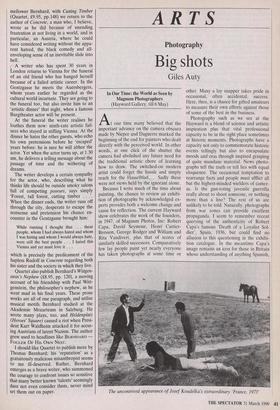ARTS
Photography
Big shots
Giles Auty
In Our Time: the World as Seen by Magnum Photographers (Hayward Gallery, till 6 May)
At one time many believed that the important advance on the camera obscura made by Niepce and Daguerre marked the beginning of the end for painters who dealt directly with the perceived world. In other words, at one click of the shutter the camera had abolished any future need for the traditional artistic chore of learning how to draw. The switched-on modern artist could forget the hassle and simply reach for the Hasselblad.... Sadly these were not views held by the ignorant alone.
Because I write much of the time about painting, the chance to review an exhibi- tion of photographs by acknowledged ex- perts provides both a welcome change and cause for reflection. The current Hayward show celebrates the work of the founders, in 1947, of Magnum Photos, Inc: Robert Capa, David Seymour, Henri Cartier- Bresson, George Rodger and William and Rita Vandivert, plus that of scores of similarly skilled successors. Comparatively few lay people paint yet nearly everyone has taken photographs at some time or other. Many a lay snapper takes pride in occasional, often accidental, success. Here, then, is a chance for gifted amateurs to measure their own efforts against those of some of the best in the business.
Photography such as we see at the Hayward is a blend of science and artistic inspiration plus that vital professional capacity to be in the right place sometimes at historic moments. Photographs have a capacity not only to commemorate historic events tellingly but also to encapsulate moods and eras through inspired grasping of quite mundane material. News photo- graphs tell the truth or tell lies with equal eloquence. The occasional temptation to rearrange facts and people must afflict all but the highest-minded wielders of camer- as. Is the gun-toting juvenile guerrilla really about to shoot someone, or nothing more than a line? The rest of us are unlikely to be told, Naturally, photographs from war zones can provide excellent propaganda. I seem to remember recent querying of the authenticity of Robert Capa's famous 'Death of a Loyalist Sol- dier', Spain, 1936, but could find no allusion to this questioning in the exhibi- tion catalogue. In the meantime Capa's image remains an icon for those in Britain whose understanding of anything Spanish, The uncontrived appearance of Josef Koudelka's extraordinary 'France, 1973' including the Civil War, is inclined to be both partial and rudimentary.
Unsurprisingly, the arts of photography and painting share virtues and vices of a remarkably similar nature: the inability of some, for instance, to make symbolic points with anything of lighter poundage than a sledgehammer. For this reason Eugene Richards's shot of a hand reaching out from behind bars towards a grazing deer, taken at a hospital for the criminally insane in Lima, Ohio, aroused more irrita- tion in me than pity. Perhaps some kind of similar reservation caused the printer of the catalogue to reverse this particular image? I was put off similarly by Hiroji Kubota's 'Black Panthers' raising their fists in unison, to a count of three, at distant, snowbound Chicago. Whether Josef Koudelka's extraordinary 'France 1973' was just as contrived I have no idea. The important thing is, it does not look so. Nor, indeed, does George Rodger's wonderful `Fellow Tribesman Carries Victorious Nuba Wrestler', Kurdofan, Sudan, 1949. George Rodger's moving elegies of Lon- don's wartime blitz were instrumental in helping sway American public opinion away from a policy of isolationism.
There are wonderful oddities, too, among the 400-odd prints on display. As many know, dogs are accomplished actors and so are skilled at pretending not to pose. Richard Kalvar's and Sergio Lar- rain's Parisian pooches are no less sym- pathetic than Josef Koudelka's hound in snowy `Sceaux Park, Sceaux, France' is balefully Baskervillean.
This last shot surely illustrates an ele- ment of happy accident. How many expo- sures were made to get this magic mo- ment? Lots of us amateurs will recall `Goodbye, Ms Ferguson. It's not that we don't want women to try to make it to the top — it's just that we prefer men to get there.' occasions when we wish we had had cameras readily to hand. Professionals are always loaded, of course, and probably even sleep with their hands on the trigger. The award-winning photograph I personal- ly never took was of a mother spooning baby-food into a child's mouth while directly behind her a mother bird fed a worm to its grateful, gape-mouthed chick. Of course, a Magnum man would never have missed a trick such as this, correctly foreseeing the occasion's pictorial poten- tial. 'Could you just hold the spoon a bit lower?' — click — 'and tell the baby to stop dribbling' — click. Life is just one big photograph, perhaps. Alternatively, a good painter could recreate a scene such as this from memory.



























































 Previous page
Previous page